Guest Post by Hayward Gladwin
Hayward perseveres in the search for Truth. His determination and dedication for the quest is something to greatly admire. It is a privilege to be able to share part of his journey and findings here. Please feel free to leave comments or questions for him below.
The Divine Origin of Nothing
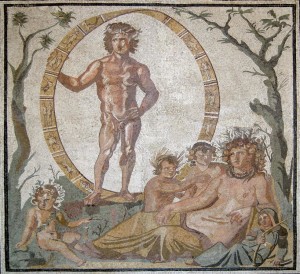
Aion and Terra (Roman version of Uranus and Gaea)
It has often been stated that behind the origin of Zero is the concept of “Nothing”. Prior to the existence of numbers and value- based systems, expressions of numeric value were made through marks and notches, such as the ancient Sumerian base- 60 system, which used simple lines or shapes to represent placement of 1’s and 10’s and so on. Or, we could look to the ancient Mayans, who used dots and lines to create a base- 20 system, or the ancient Chinese that used simple horizontal and vertical lines to create their base- 10 system.
In in each instance however, a need to indicate a numerical value of an “absence” became present; not only to create the conceptual counterpoint to the positive integer, but to also give cause for their numeric systems to escalate in cycle, from 10’s to 100’s to 1000’s and so forth. For this purpose, a symbol expressing the value of a “void” was created, one that could act both as a beginning to the entire numeric system, yet also give rise the cycle of scales (10s, 100s, 1000s, etc.) as it increased.
However stylized the character of Zero might appear today, it would seem that the most rudimentary form of the zero is a circle or oval. In a few of the ancient cultures mentioned above (with the Sumerian being an exception) the form used to represent the zero could typically be described as a space enclosed by a curved line, thus creating what would appear to be a vessel-like circular or ovular form.

 Mayan Zero (top), Chinese Zero (bottom)
Mayan Zero (top), Chinese Zero (bottom)
The significance of this form in relation to a concept of cycles, and thus regeneration, should perhaps not be underestimated. The idea behind regeneration would be the point where the mark of the beginning becomes the inevitable end and then goes onward toward another beginning. Note how the Mayan form on the left even resembles an egg, a form that symbolizes the idea of creation and the generation of life itself. To create a symbol for “nothing” therefore, is to also create the visual allegory for an empty womb so to speak, and thus giving counterpoint for the definition of “something” to begin with, thereby complying with the principle of duality. Things start to get really interesting though, when we think of the form of Zero not simply as the state of pure nothingness, but also the kinetic state of “somethingness”, an idea that somewhat engenders the form of the circle with the principle of rest and creation, somewhat like an act of God.
In fact, if we look at a common term associated with the geometric measurement of the circle, it would seem that we happen to stumble upon the idea of the Gods or Goddesses themselves. If we take the word “diameter” and dissect it into its two components “dia” & “meter” we have two words which take root in Greek. The word dia, which is translated in Greek as meaning “through” or “across”, when taken back through the Latin “Dea”, and then to the Greek “θεά (Thea)”, a reference to a “Goddess” appears. In Latin, Dea literally means goddess, and in Greek, Thea is the daughter of Ouranus (Uranus- God of sky or heaven), who represents the aithre (ether). Additionally, in ancient Greek myth, the name Dia has been defined as meaning “heavenly”, “divine” or “she who belongs to Zeus”. The word meter, on the other hand, means “measure” in Greek.
Considering this reading of diameter, are we to conclude that the measuring the span of a circle is akin to measuring a “Goddess, the heavenly or divine”? Are we also to consider that the form of the circle is feminine in principle and related to the idea of creation? It is an interesting thought. To explore this idea further, we should continue to look at the origins of the circle and try to connect these ideas with what we find.
When thinking about the idea of the circle as a generative principle of creation (therefore as a feminine concept) I’m naturally reminded of the idea of “mother earth”.
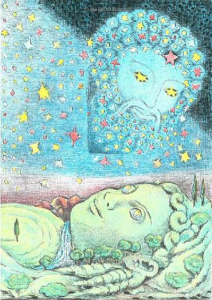
Turning back again to ancient myth, we find that the consort of the Greek Ouranos (Uranus) is Gaia, the primordial goddess of Earth. In ancient Rome, these Gods were known as Aion and Terra. In the Greek myths, the two were parents to the lesser Titans, which themselves were later overthrown by the classic Greek gods of Olympus. Ouronos symbolizes the sphere of the heavens (Zodiac) and Gaia the sphere of Earth. In this illustration, we see the two look back and reflect upon the other. Of related interest here, to the idea of “diameter”, is the word “geometry”, which means “Earth-measure”. Here, we see that “geo-metery” also seems to have its root in relation with the name of a Goddess, this case being Gaia. It is perhaps also interesting to consider that by attempting to make a two dimensional representation of a sphere, we might be first prompted to draw a circle. In this way, I am again reminded of the connection between the idea of creation (Earth Mother) and the geometric form of the circle.
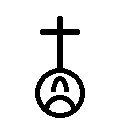
But whereas the precise “first” origin of the Zero (or at least the concept of the zero) is debatable, it is often agreed that one of the earliest recordings of symbol used to express “nothing” (or Zero, effectively) was made by the Egyptians. This symbol was named NFR (“Nefer”) and means “beauty”, in addition to its being used for representing the concept of “nothing” in written form.
It has been stated by some that the NFR symbol could be looked as representing an abstraction of the human form as esophagus, heart and lungs. But perhaps even more interesting is how similar this symbol is related to others, such as how it looks like an inverted symbol of Venus, or how similar it is to the alchemical symbol for Antimony. If we continue to follow the historic traces of this symbol in depth in fact, many associations with esoteric ideas start to form.
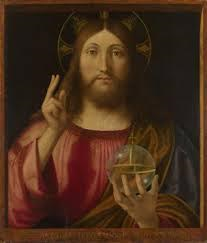
Another image that the NFR symbol bears a resemblance to is the Globus Cruciger, an object commonly held by Christ being portrayed as Salvator Mundi, or “Savior of the Earth”, a theme found in many Renaissance paintings. Whereas the globe makes a clear reference to “The World” (in latin: Mundi), the cross is an easy association to make with Christ. (Side note: notice how the hand gesture echoes this form with fingers crossed and the remaining fingers clenched together).
This symbol was often used to convey an image of power or influence and was used to depict the divine, but also worldly, power and so was often seen being held by kings or queens in portraits. Meanwhile, while the handheld globe clearly indicates a position of terrestrial or spiritual dominion, we might also notice how the cross on top of the sphere seems significant in relation to the crucifixion, specifically when considering its location on the mount of Golgotha, with its rounded shape and its name meaning the “place of the skull”. In fact, many iconic paintings show a skull buried under the mound where Christ was crucified. The skull relates to a legend that it was the skull of Adam that was buried there, inside that mound of Earth.
It is along these lines where we could further elaborate on the theme of a void or vessel with a cross and turn our focus to two worldly locations: one to be found in Egypt and the other in England.

In Egypt, in the tomb of Tutmosis III, there is the depiction of a scene called the “Amduat”, which has also been referred to as ” The Book of the Hidden Chamber and the Twelve Hours of the Night”. The scenes in this “book” describe the 12 passages of the sun god Re as he travels through the night and below the surface of the Earth, so to appear on the opposite horizon the next day. As he does so, it is interesting to consider that while he rides on his bark over water and through the darkness, we have an image of his travelling through a void, “nothingness”, or the unknown. At the bottom center of this image, which is positioned at “6 o’clock”, we see an image of Re standing within an ovular form, surrounded on both sides by wings and flanked by serpents. On two levels above, there is what appears to be an upturned vessel surmounted with a “T”. The form is peculiarly similar the NRF symbol or the Globus Cruciger, if considered in abstract terms. The “T” has widely been known as an earlier form of the standard four-armed cross. And in fact, when we check the name used to describe the central location of this point within the Amduat, it is “Rostau”. It is quite easy in this word to find relevance with the “Rose Cross” (Rose Tau) of the Rosicrucians.
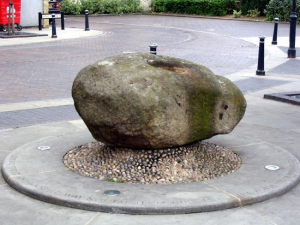
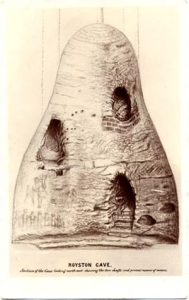 Heading over to England, there is a similarly-designed site located at the crossroads of the historic paths of Ermine and Icknield, at Royston Cave. This cave, as has been discovered, was used by members of an unverified mystery society and it has been speculated that it was also used for ritual. The shape of the cave is of a void carved out of the earth in the shape of a bell-type vessel. Above this cave, on the ground above, there was a cross that used to stand there. The name of this cross was “Rosia’s Cross”. Remnants of the cross’s base have been found at this intersection and supposedly remain there today. Through “Rosia’s Cross”, we are again introduced to the concept of the Rose Cross (Rostau) and when it is combined with the cave beneath, we are again presented with the image of a void with a cross above.
Heading over to England, there is a similarly-designed site located at the crossroads of the historic paths of Ermine and Icknield, at Royston Cave. This cave, as has been discovered, was used by members of an unverified mystery society and it has been speculated that it was also used for ritual. The shape of the cave is of a void carved out of the earth in the shape of a bell-type vessel. Above this cave, on the ground above, there was a cross that used to stand there. The name of this cross was “Rosia’s Cross”. Remnants of the cross’s base have been found at this intersection and supposedly remain there today. Through “Rosia’s Cross”, we are again introduced to the concept of the Rose Cross (Rostau) and when it is combined with the cave beneath, we are again presented with the image of a void with a cross above.
There are other instances in history wherein caves we used for ritual purposes, such as the caves used for the Mithraic rituals, or the ancient BES chambers used in Egypt. There is something about the idea of using a cave for ritual that is womb-like, particularly with relevance to such Solar or Fertility deities as Mithras or BES, wherein the implication of fertilization into the Earth is present.
 And if we return back to basic circle as a symbol of cycles; of beginnings, endings, and the concept of (re)generation, we can in yet another way connect to an idea presented earlier by the 12 hours of the book of Amduat — and that would be through the concept of time. A natural connection to the measure of time and the 12 hour cycle would of course be the clock.
And if we return back to basic circle as a symbol of cycles; of beginnings, endings, and the concept of (re)generation, we can in yet another way connect to an idea presented earlier by the 12 hours of the book of Amduat — and that would be through the concept of time. A natural connection to the measure of time and the 12 hour cycle would of course be the clock.
And it is perhaps only coincidence that the Latin-based word for “Day” is “Dia” (in ancient Latin- Die, pronounced dee-eh). Or consider the relationship between the word “day” with the “dae” or “dei” of daemon and deity. With this hypothesis, we can bring together the concept of the cycle of a day in relation to the female goddess, or “Dia”. It might help to shed new light on the famous quote of “Et in Arcadia Ego”also, wherein a new reading might be: “and in the Arc (or circle) of the Goddess (Dia) I am”.
It is important to keep in mind however, that this 12 hour scale of time is based on the Earth’s rotation on its own axis. To look for another scale of time, and therefore another circle, we could also follow the Earth’s revolution around the sun and find what in that case would be a solar measure, the year. There is thus reason to insist that the time-related idea of the circle pertains to both the Earth and the Sun. But these wouldn’t be the final “cyclical circles” to be found, since looking at how our solar system revolves around the galactic center, we would find yet another. Then in considering all the galaxies revolving around some unknown center out there in the universe, perhaps even yet another. Not to mention the concept of Precession wherein, as the Earth travels “forward” through the Zodiac, the dates of the Equinoxes appear to travel “backward” through the signs of the Zodiac, over a period of 25,625 years.

Yet, to introduce the Divine nature of the circle, and the generative principle of creation, it makes sense to begin with the Earth, since this is where we first find ourselves. From this vantage point, we can bear witness to the “music of the spheres” as well as the sphere of the heavens. We can also see, with some help from the teachings of our ancestors, a measurement of time that is both Earthly as well as Cosmic.
From this perspective we can find yet another clue that ties together Divinity and the Earth, by using a symbol that the ancients used to reference the Earth, that being the Square. The elemental square, of which Platonic schools had used to symbolize Earth, references the equality of the classic four elements (Fire, Water, Air, Earth), but is also vital due to the measurement of its angles. If we add up the four angles of a square (90 + 90 + 90 + 90) we come up with the same number of degrees which are found in a circle, 360. With this information, perhaps we have another means to consider the famous problem of “Squaring the Circle”, in which we are told to find an equal amount of area within both. But rather that limiting ourselves to physical area, perhaps we can find another truth contained within the measurement of their degrees. Thus the underlying message might be read, “Within the degrees of the Earth are also found the degrees of the Divine.”
If we are to find the first steps towards discovering the relationship between the Divine (Nothing), the circle, and Earth, we should refer back to the aforementioned symbol of Antimony and learn of its meaning in alchemy.

It has been said that the metal of Antimony symbolizes the animal nature or wild spirit of humankind. Had we not previously considered our animal nature or wild spirit through association with the rough stone, Asmodeus, and Marsyas (aka Pan)?
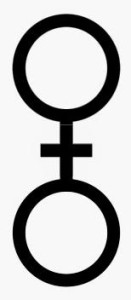 To conclude, perhaps it is now worthwhile to reflect back on how the NFR symbol, or Antimony, appears as an inverted symbol of Venus. As had already been suggested, to complete the symbol of Venus is to embrace the entire tree of life. And perhaps now we are able to see the point where to begin, from its reflected image found within the elements of Earth. To make the leap, it is starting to look like a symbolic bridge between the lower sphere and the upper sphere, using the cross in the middle as the guide.
To conclude, perhaps it is now worthwhile to reflect back on how the NFR symbol, or Antimony, appears as an inverted symbol of Venus. As had already been suggested, to complete the symbol of Venus is to embrace the entire tree of life. And perhaps now we are able to see the point where to begin, from its reflected image found within the elements of Earth. To make the leap, it is starting to look like a symbolic bridge between the lower sphere and the upper sphere, using the cross in the middle as the guide.
And maybe from there, just maybe, we might catch a glimpse of what the true nature of “nothing” is; something a bit higher above (or perhaps even another sphere beyond), yet at the center of that which exists before and beyond everything else. Perhaps this is the true form of the creator. For isn’t it an oft-used quote that “God is a circle (or sphere) of which the center is everywhere and the circumference is nowhere”?
*Disclaimer- the ideas and findings in this article were inspired and informed in part by the Maranatha, Et in Arcadia Ego book series. The author is not affiliated with the publishers or authors of Maranatha and the conclusions herein are solely the author’s own.
Other Articles by Hayward:
A Masonic Meaning to January 17th?
The Tower of the Knights Templar
The Skull on the Tomb, The Rose on the Cross
A Demon, A Stone, and the Aspirant


Thanks for sharing such interesting thoughts, Hayward. Always inspiring and encouraging the Quest!
As I mentioned to you, the NFR symbol is one I have researched as well, and so the information you share here I find especially intriguing.
It seems paths are always crossing in explorations, and I am so glad they do!!! It can be lonely sometimes walking along by oneself…lol…..(but love the journey)
I agree that time seems to be a fundamental factor in this quest. Will post more thoughts about this later.
Awesome article, Haywood!!! The circle is the perfect symbol for God because it represents nothing. For me, everything begins and ends with the circle. You also raised a lot of other interesting points, especially in regards to the Cross, and how this seems to relate to the understanding of the Rose Cross. I’m glad that you included the picture of Salvidor Mundi. The clue that this is Rose Cross seems to be right there in the painting.
HI Mark- I like how you framed the first two sentences, “God because it represents nothing” & “everything begins and ends with the circle”.
This is exactly how I am seeing it also.
In the second article I wrote, “A Skull on the Tomb, a Rose on the Cross”, the symbol I was equating with the Rose Cross was the Crux Ansata or Venus symbol, as I believe it represents the “higher” aspect of this symbol, since it touches every sphere of the Tree of Life. The NFR, or Antimony, symbol is an inversion of this, especially because it is an earthly symbol, and could perhaps be read as the beginning because the “higher” symbol reflects into the world below, as if the lower realm were a mirror of that above. First starting with the ‘reflection’, continuing ‘upward’ into the ‘upright’ symbol.
This is only a description of the progress explained in terms of the ‘direction’ one would travel (from below to above), in a linear fashion, so to speak.
The thought in my mind that the ‘upright’ form of the symbol in the Salvatore Mundi painting exists in it also pertains to the hand gesture on his right hand. A blessing, or sign of the cross, is done with this hand gesture and would of course place the cross from head to heart and from shoulder to shoulder. The ‘halo’ presents the circle above the cross in this manner, as the Globus Cruciger in his left hand is the ‘inverted’ sign of the same, suggesting the mutual nature between them.
Thanks for explaining that. What your saying is that the Cross can be used for the purpose of understanding the connections between the Seferet in the Kabalistic tree of life as well as being a symbol for the understanding of the reflective principle, where the higher (heavenly) world reflects the lower (illusionary) world.
What I find interesting about the ellipseses which forms the cross inside of the globe is that if you fill it in with color inside of the circle, it seems to add Demension, but it was just an idea that I felt like playing around with.
The cross in combination with the hexagram can be used to build the tree of life.
As for the reflective principle, I find it’s best expressed with the two circles intersecting into a vesica pisces. There’s a cross on both circles, and the crosses reflect each other.
True Maria. That’s why Vessica Pisces is often referred to as “The Mirror of Consciousness.” The Sufi Poet Rumi often hinted at it in two of his poems, “Be Lost in the Call” and “A Great Wagon,” both of which also happen to be my favorite two poems by Him: Here are the links to the two poems just in case you or others are interested.
http://www.khamush.com/poems.html
http://www.onbeing.org/program/ecstatic-faith-rumi/feature/great-wagon/1855
Actually, Venus is almost always identified with the beginning of the journey, rather than the end.
And antimony is one of the names that has been given to the philosopher’s stone, though to be fair, it has been given so many names that I don’t know how significant is that.
I don’t think it’s that simple. The order may not be as successionary as it may seem.
And in any regard, it would appear as the ‘middle point’.
I have no idea which tradition ‘begins’ with Venus, if there is one, it absolutely isn’t Kabbalah-based. To get there requires several steps, one does not start there.
Antimony is not a name for the philosophers stone, the stone is a product that comes out of working with it.
As you know, I’m pretty sure the symbol that corresponds to the Rose Cross is a hexagram with a cross.
And the crux ansata is normally understood to be the ankh, that is a little different from the Venus symbol. It has an inverted tear shape, rather than a circle.
If you draw a pentagram inscribed in the circle of the Vitruvian man, you’ll see that the horizontal line goes right through his outstretched arms, and the two lines that make the top point of the pentagram cross this line at his shoulders. The centre of the pentagram is his navel. If you also draw a vertical line from the top point of the pentagram down to his feet and going through his navel, you will see that there is a cross going through the traditional locations of the sign of the cross hidden in this picture.
Other geometrical constructions also show that the heart is an important point.
I’m now much more certain that I was correct in my original guess that the true symbol behind the rose cross is the hexagram and the square (a square can also be represented by the diagonals, making a cross). The reason the rose is the hexagram, with six petals, and not the pentagram, in spite that wild roses have five petals, is because the flower that was originally called “rose” was the “rose of Sharon”, or the lily.
awesome post…I enjoy reading this kind of stuff…always believed the circle was the most powerful symbol in the universe, once i told my friend that and he said the triangle was..
Sometimes, people make the case that the triangle is the more powerful symbol for the reason that the reason that the triangle is composed of 3 lines, so is the first form to be derived from the void. The downward pointing triangle represents Shakti (female generative energy) and the upward pointing triangle represents purusha (male generative energy). So when the two triangles intersect to form the Hexagram, with the apex’s of the triangles facing in opposite directions, it represents the birth of the creation and the expansion of time and space. But it’s actually the circle which causes the power of the triangles to manifest.
nice post Mark…never knew any of that… my friend was jewish, if that has anything to do with it?
Ha Ha! I’m not sure if his being Jewish had anything to do with the triangles. Here’s a really excellent article that pertains to the symbolism of the Circle, Triangle, Point, etc. as this relates to the understanding of Tantra. I learned a lot by reading this article. It’s for both you & all of my other friends at MW. Enjoy!!!
Here it is ….
http://web.stanford.edu/class/history11sc/pdfs/yantra.pdf
ha yeah i dont know…their symbol is 2 triangles so i thought that had something to do with it
Your probably right. The only Jewish Symbol that I know is the Menorha. lol!
I don’t think the ancients related time to the Earth. First, because most of them thought that the Earth was fixed, though rotating. Secondly, many wouldn’t call our planet “Earth”, but rather “the world”. I think the ancients related time purely to the heavens, with the Earth being just a reference point.
You ,yourself, spoke about how the ancients would have tracked a constellation the Sun was positioned in by looking at the opposite direction of the sky at night. Yet they didn’t understand that earth rotated on its own axis?
Look at some ancient Greek pottery with the constellation of Cassiopeia inverting in four positions and see how this happens around the pole star.
3 W E M
The clues point to the phenomena of Earth (in either an alchemical or planetary sense) and the heavens being joined. This is one purpose of the symbol of the Labarum.
I haven’t said they didn’t know the Earth rotated. Of course the educated people among the ancients knew that. But I don’t think that the Earth orbiting around the Sun would have been common knowledge, if it was known at all. Most people certainly assumed that the Sun orbited around the Earth.
It’s true they had a concept of the Earth and the heavens being joined at an axis that went through the pole star. But mostly, I get the impression they thought of time as a property of the heavens, and anything on Earth was at best an imperfect reflection of it, or due to a weak connection with the heavens through the axis.
No, not like how you describe, but like how “the two bands which form the “world soul” (anima mundi) cross each other like the letter chi.”
It’s true that you can cover the tree of life with the symbol for Venus, but I have found no evidence that Rosacrucians commonly did that. What they definitely covered the tree of life with was with a hexagram.
You won’t find much evidence of the Rosacrucians doing much of anything actually, since there is very little that they released to the public. Some literature, some illustrations, some hidden symbols, and a lot filled in by people like Golden Dawn groups that elaborated on their work.
Unless of course, you’ve somehow managed to open the tomb of Christian Rosencreuz!
Thanks Nate-
I know you’ve studied a lot about alchemy, so I’m glad you got something out of it. Soon, I’d like to cover a subject on the basic meaning of some of the alchemical symbols. Maybe I’ll pick your brain on that one.
The most pivotal Dr. John Dee, central to so many of the ‘deeper’ metaphysical explorations, good suggestion. I haven’t followed hardly enough of his work, and for some of his ‘discoveries’ I wouldn’t even dare to encroach upon them.
My perspective on the subject is very limited as well, but I have seen a very basic understanding of at least some of the symbols that I think are valuable to look at.
Pingback: Intuition - Page 120
I think that going from “diameter” to “goddess” is just taking etymology a bit too far.
Keep thinking……
The circle is feminine in principle because it’s associated with the moon, that is traditionally feminine because of its 28-day cycle. The sun, that is traditionally male, has less association with a circle because it’s also associated with fire, that has the shape of a triangle. In esoteric terms, the geometric figure associated with the sun is the Templar cross.
What is the alchemical symbol for sun?
I know it’s a circle with a dot, but most of the planet symbols have circles in them. My point is that a circle on its own and with nothing else added to it, is more likely to be a feminine symbol. Then, it might just be a circle. I always say it’s best not to read too much on single things.
“My point is that a circle on its own and with nothing else added to it, is more likely to be a feminine symbol.”
Thank you for supporting the primary thesis of my article.
However, taken in context of the planets and alchemy, as I made example of in “A Skull on the Tomb…” this circle has a different meaning, and it would appear to be solar.
The gesture of Christ in the picture looks to me more like a blessing than crossed fingers.
As several have spoken about how the hand gesture symbolizes: “IC XC”
http://40.media.tumblr.com/a178d7b357f02cd742a9123a2abdd3bf/tumblr_myufn8pUr01s1fgejo1_500.jpg
Sometimes symbols do have meaning outside the obvious.
So reflect on the “x” and “c”….
“Rostau” means “underground tunnels” in ancient Egyptian. It’s highly unlikely that the word had influences of Latin and/or Greek, since those times were before the Romans could be called civilised, and the Greeks were somewhat more cultured, but certainly still below the level of Egypt at the time. From the point of view of ancient Egyptians, both would have been considered barbarians.
And the ancient Egyptian language was forgotten and rediscovered only in the 19th century, so Egyptian words wouldn’t have been known to the people who started the order of the Rosacrucians.
Further Google searches show additional interpretations of Rostau:
“Mouth of the Passages”
“Gateway to the Otherworld”
“The Egyptian name for Giza”
Passages or Gateways could be interpreted literally allegorically, or metaphorically.
In any regard it is a narrative describing the passage of the Solar god passing through darkness at night.
As far as Latin or Greek being imposed onto the Egyptian name of Rostau, the direction of the influence you describe, in my mind, is backwards. The idea is that the name of Rostau, as the Egyptians used to describe the Giza complex, and the depiction of what happens in the Amduat, influenced either Greek and Latin scholars (or initiates) in that the terminology had meaning in their own language. It is this “translated” symbolism that carried forward and became a symbol that appears today as a signifier that seems to have lost what it signifies. Which isn’t to say that is hasn’t gained further meaning throughout its history, but in terms of its origin, it would appear to stem from this point.
“Ros” would have connection to “Rose” through Greek “Rhodos” or Latin “Rosa”. So if you were a native speaker of either of these languages and heard the Egyptian name “Ros” spoken, it might sound to you like the person was talking about a Rose. Same for Tau, which has obvious meaning for Greeks as a “T” or “Cross”. Which isn’t to say that it was a mis-translation, but that the meaning of the terms in their own languages seemed to enhance its meaning. Others have also written about these associations- you can look them up yourself.
There is a similar effect of what happens in the translation of an idea, such as the “gesture of silence” of placing the finger over the lips (in esoteric tradition) stemming from, or at least related to, the infant Horus who places his finger to his mouth as a sign of innocence. Yet, the combined meaning of these two interpretations enhances the meaning of the gesture.
As one author writes: “For thousands of years the knowledge of this marvelous Stone has been the sole province of mystical brotherhoods including Egyptian Priests and Pharaohs, Melchizedek Priests, Arabian Schools, Rabbis,Cabbalists, Indian Yogis, Rosicrucians, Freemasons and lone Jewish alchemists.” The mysteries that these groups carried forward can be traced throughout history and throughout the continents. What they carried with them is ancient in origin and it’s meaning has been preserved. This is outside of what the mainstream professes to know or understand.
I’m not aware of the expression “rose and cross” existing much before the official beginning of the Rosacrucian order. Poussin was almost certainly aware of it, but that isn’t earlier. I’ve encountered no evidence of it existing among the Greeks or the Romans. This isn’t to say they didn’t have a similar concept, but I think at the time they used Christian symbols for it.
You are mistaking the symbol itself for the idea behind the symbol. If you look for the idea behind the symbol, this is the importing thing that has survived. The name is not important but to trace its path or origin.
I’m pretty sure I’ve figured out what the philosopher’s stone is (though not how to use it). If I’m right, it’s true that it was known only by members of mystery cults, secret societies and the like for many centuries, perhaps as much as two thousand years, maybe even more (the author you quote might have had access to privileged information). But today it’s public knowledge, though somewhat obscure. It fits with what Duncan said: “To discover that E=MC2 was known centuries before Einstein scratched it on chalkboard would be an impressive discovery.”
Even if you have discovered what the Philosopher’s Stone is, it doesn’t matter. Even if you think you figured out how to use it, or how it works, it wouldn’t matter since there is no way to accomplish this without first making the necessary preparation and lengthy work to start to have even a hope of accomplishing it. It is not a course easily understood, although there is hope in finding the beginning of the trail, nor is it easy to maintain without solid guidance.
Nate- I am seeing that there is perhaps more behind this than I first realized. Great!
Pingback: Onward! - Page 18
The Mayan symbol for zero is supposed to be a shell, not an egg. Anyway, no reason to think it has any connection with Arabic numerals.
If your point is that people around the world have chosen a dot or a circle as symbol for zero around the world, even cultures that had no connection, there is some truth in it, but it’s easy to find other examples that weren’t. The Babilonians used cuneiform and their symbol for zero was, like all their writing, in cuneiform style. And Romans used N (nulla) to indicate zero.
Egg or Shell, the shell comes from the egg. The point is not that people intended to create a symbol with the same meaning in mind but that looking back to history, there is a solid thematic connection that might help in our understanding of what the idea means to us, as well as maybe to those in recent esoteric history.
For anyone else who is interested, the premise of the Mayan symbol and the Chinese symbol came from this:
30th March 2007
‘Look to where nothing was recorded to discover the first path’.
30th June 2007
‘The Ancient Aztecs and Ancient Asians knew the secret of nothing’
By the way, the Babylonian numeral system is often known as the Sumerian/Babylonian system, although the Babylonian empire succeeded Sumerian, and I referenced the fact that it’s character for zero is not the same earlier in this article.
“And the Romans used N to indicate zero”. Stating this fact does not retract from the premise of God extending into the description of a state of “nothingness” in the sense of the infinite, as this article is attempting to do.
One interesting thing about “the music of the spheres”. It’s actually true that the distances of the planets to the sun follow the same ratios as a musical chord (one way of thinking about it would say it’s based on the 7th chord). But to realise that, you need to have calculated the distances of the planets to the sun. Which, according to official history, didn’t happen until Copernicus.
“God is a circle whose center is everywhere and the circumference is nowhere”
Voltaire is the one that said that. He was only initiated on freemasonry just before he died, though I accept it’s quite possible, even likely, that he was informally initiated in some mysteries before that. But it’s a fair guess that when he said that, he wasn’t making any esoteric statements. I think a real occultist wouldn’t have said that the center is everywhere.
Prior to Voltaire, this quote has been previously attributed to:
Hermes Trismegistus
St. Augustine
Nicholas of Cusa (actually, a theory based on his description found in his de Docta Ignorantia- Of Learned Ignorance)
Blaise Pascal (although some claim it was not “God” but “nature” he spoke of)
Its a fair guess then that when he said that he was simply quoting an idea that had previously existed for many years before his time, whether or not he had joined Freemasonry.
I’m still not sure why you persist when what you are attempting to conclude is so very far from the mark. “A real occultist wouldn’t have said that the center is everywhere.” Actually, by expressing this quote, these individuals were likely making a comment showing them privy as to the connection of their occult understanding.
Pingback: The Tower of the Knights Templar » Mysterious Writings
Not sure how the Greeks would have spelled Rostau… if they knew about it, with Egyptians being pretty secretive about their temples and other sacred things.
I’m aware now of a few more things that I wasn’t aware of before. I have good reason to doubt that overlapping the symbol of Venus on the tree of life leads anywhere. On the other hand, it’s definitely useful to remember the “lightning” – the order of the spheres on the Tree of Life.
.
Hi Hayward,
Came across this again (thanks for your contributions here). Since the tweleve.org site is non-functional now, I would like to make a general heuristic observation here. We usually work and ponder under the idea, that the nature of Reality is the same now, as it was through the history, for the ancients and up until our day. If this is true, then their many observations, comments, analogies / archetypes and representations are pointing to something (and I’m guessing not always so precisely) that is available for our direct investigation. A primary question(s) is
“Why is there something (everything) where there should be Nothing?”
“What is the relationship between the Nothing and the Everything?”
An intellectual investigation may not reveal the ultimate answer.
https://en.gravatar.com/userimage/61406373/d7a0e84dced934d0d8cf8ae95f755aaf.jpg?size=200
astree